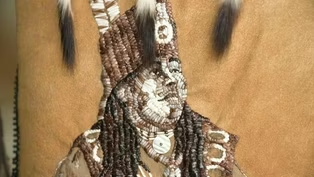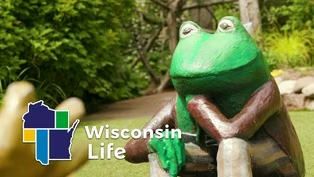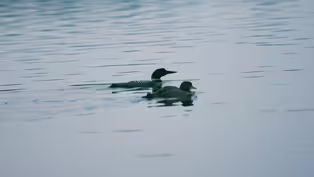
Little known truths about lilies of the valley
Clip: Season 12 Episode 3 | 4m 24sVideo has Closed Captions
Nancy Jorgensen reflects on her grandmother's lilies that still bloom today.
In 1977, a grandmother shares lilies of the valley with her newlywed granddaughter. Four decades later, those same lilies transform Nancy Jorgensen's spring garden while connecting three generations of women, each shaped by different freedoms and constraints. Her Nana’s legacy lives on in blooms that represent resilience, growth and evolving norms.
Problems playing video? | Closed Captioning Feedback
Problems playing video? | Closed Captioning Feedback
Wisconsin Life is a local public television program presented by PBS Wisconsin
Funding for Wisconsin Life is provided by the Wooden Nickel Fund, Mary and Lowell Peterson, A.C.V. and Mary Elston Family, Leon Price & Lily Postel, Stanley J. Cottrill Fund, UW...

Little known truths about lilies of the valley
Clip: Season 12 Episode 3 | 4m 24sVideo has Closed Captions
In 1977, a grandmother shares lilies of the valley with her newlywed granddaughter. Four decades later, those same lilies transform Nancy Jorgensen's spring garden while connecting three generations of women, each shaped by different freedoms and constraints. Her Nana’s legacy lives on in blooms that represent resilience, growth and evolving norms.
Problems playing video? | Closed Captioning Feedback
How to Watch Wisconsin Life
Wisconsin Life is available to stream on pbs.org and the free PBS App, available on iPhone, Apple TV, Android TV, Android smartphones, Amazon Fire TV, Amazon Fire Tablet, Roku, Samsung Smart TV, and Vizio.
Providing Support for PBS.org
Learn Moreabout PBS online sponsorship[gentle music] - Nancy Jorgensen: It was May 1977 when my grandmother, Nana, led me to her basement, past the black iron cookstove, then the shelves of home-canned beans and beets.
I sniffed the stale scent of Wisconsin wood fires and the mustiness of potatoes in storage, odors familiar to me since childhood.
"Come see the lilies," Nana said, as she leaned the screen door open and planted one leather shoe into her shady backyard.
I was 22 and just married, but Nana's gardens still felt like home.
"Bring that shovel," she said.
"We'll dig some for your new house."
Nana cultivated other species too.
Phlox, daffodils, violets, pansies.
She coaxed each into a vibrant melody until her country yard trilled with color.
Every year a new song, but her refrain always lilies of the valley.
Four decades later, Nana's darlings transform my spring landscape from a dirt and grass hoedown to a frothy white minuet.
Nana has been gone many years, but her lilies still sing and sway.
Nurseries call them a high-maintenance plant, but Nana considered their spreading a virtue.
Their duty in life, like hers, to place roots, scatter beauty, and pass gifts on to a new generation.
Lilies of the valley thrive in shade.
As a woman of the 1920s, so did Nana.
Her list of chores cast long shadows over each day.
Wife and mother was not her first choice of vocation.
Many years earlier, she dreamed of an education and a life devoted to healing.
"I always wanted to be a nurse," she said.
Instead, she lived, like neighboring farm wives, in her husband's shadow, reflecting warmth and light toward him.
Like Nana, lilies of the valley rise early and bloom in the dawn of summer.
Slender columns strut low to the ground, each boasting up to a dozen tiny flowers.
Pure white, only millimeters across.
Lilies of the valley symbolize rebirth, purity, youth, and happiness.
But Nana delivered them to the grave of her son, a sailor in the U.S.
Navy, and later her husband, who died at only 59.
And then another son, whose heart suddenly gave out.
In life's valleys, her lilies intoned a requiem.
My 30-something daughters inherited Nana's love of gardening.
Gwen, a professional athlete, sows kale, plants parsley, and nurtures her bed of mint.
Elizabeth buys seedlings from her high school students, who grow them in biology.
For my daughters, planting is play.
The stakes are low.
If their gardens produce, they make a caprese salad or add chives to lettuce from the farmer's market.
They have none of Nana's worries about climate's uncontrollables, like rain, sun, drought, cold, or heat, that could result in hungry children.
Two generations on either side of me relishing the wonder of a seed, the beauty in a bloom, the gratification of growing.
Nana's gardens became her vocation.
She buried regrets and tended her plants as she would have tended patients.
My daughters garden at their leisure, free to pursue their callings: teacher and writer, professional athlete, or nurse, if they so choose.
[door opening] [gentle music]
A botanical garden meets children's literature
Video has Closed Captions
Clip: S12 Ep3 | 3m 18s | Angela explores Sheboygan's Bookworm Gardens, where children's books come to life. (3m 18s)
Porcupine quills connect past and present for artist Melanie Sainz
Video has Closed Captions
Clip: S12 Ep3 | 2m 52s | Ho-Chunk artist Melanie Sainz blends tradition and pop art with porcupine quills. (2m 52s)
Preview: Sheboygan's Bookworm Gardens
Preview: S12 Ep3 | 15s | Stories come to life at Bookworm Gardens in Sheboygan, a literary botanical oasis. (15s)
Research reveals Wisconsin loons are disappearing
Video has Closed Captions
Clip: S12 Ep3 | 7m 14s | Walter Piper documents declining loon populations in northern Wisconsin. (7m 14s)
Ashland motorcyclist earns Guinness World Record after global journey
Video has Closed Captions
Clip: S12 Ep3 | 4m 44s | Bridget McCutchen becomes youngest person to circumnavigate the world by motorcycle. (4m 44s)
Providing Support for PBS.org
Learn Moreabout PBS online sponsorshipSupport for PBS provided by:
Wisconsin Life is a local public television program presented by PBS Wisconsin
Funding for Wisconsin Life is provided by the Wooden Nickel Fund, Mary and Lowell Peterson, A.C.V. and Mary Elston Family, Leon Price & Lily Postel, Stanley J. Cottrill Fund, UW...


















